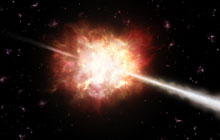Gamma-Ray Bursts
One of the Most Energetic Phenomena in the Universe
Gamma-Ray Bursts (GRBs) are bursts of highly energetic gamma rays lasting from less than a second to several minutes – the blink of an eye on cosmological timescales. They are known to occur at huge distances from Earth, towards the limits of the observable Universe.
The VLT has observed the afterglow of a Gamma-Ray Burst that is the farthest known ever. With a measured redshift of 8.2, the light from this very remote astronomical source has taken more than 13 000 million years to reach us. The Gamma-Ray Burst is thus seen when the Universe was less than 600 million years old, or less than five per cent of its present age. It must have released 300 times as much energy in a few seconds as our Sun will in its entire lifetime of more than 10 000 million years. GRBs are therefore the most powerful explosions in the Universe after the Big Bang. See ESO Press Release eso0917.
Researchers have tried to discover the nature of these explosions for a long time. Observations show that GRBs come in two types – short-duration (shorter than a few seconds), and long-duration – and it was suspected that two different kinds of cosmic event caused them.
In 2003, astronomers using ESO telescopes played a key role in linking long-duration GRBs with the ultimate explosions of massive stars, known as 'hypernovae'. By following the aftermath of an explosion for a whole month, they showed that the light had similar properties to that from a supernova, caused when a massive star explodes at the end of its life.See ESO Press Release eso0318.
In 2005, ESO telescopes detected, for the first time, the visible light following a short-duration burst. By tracking this light for three weeks, astronomers showed that the short-duration bursts – unlike the long-duration ones – could not be caused by a hypernova. Instead, it is thought that they are caused by the violent mergers of neutron stars or black holes. See ESO Press Release eso0541.
